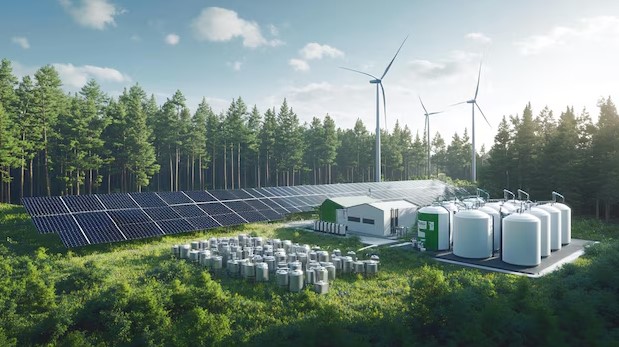Hydrogen is the most abundant element found in nature. Until recently, the use of hydrogen did not have an environment-friendly dimension. Most of the hydrogen was extracted through a process called steam methane reformation (SMR) of natural gas.
The process emits a large amount of carbon dioxide and contributes to increasing carbon footprint. Depending on the method of extraction, the hydrogen extracted is named grey, brown, blue, yellow, turquoise and pink, among others.
Hydrogen, unlike other renewable sources, can be used in the existing infrastructure meant for both natural gas and liquid fossil fuel.
Where India stands
For India, the momentum currently surrounding the hydrogen transition efforts needs to be situated within the context of a low-carbon economy, energy security, and the larger economic development ambition of the nation.
India’s thrust towards a low-carbon economy currently hinges on an accelerated transition towards a higher share of renewables in the electricity grid complemented by electrification of end uses such as transportation.
But there is a tacit recognition that materials critical to industrialisation and urbanization such as steel, ammonia, cement, and plastic have no substitutes and cannot be decarbonized with electricity alone. Green hydrogen is a necessary lever to achieve a truly low carbon economy.
For India, this transition can be synergistic with the scale, ambition, and economic competitiveness of its renewable industry. Unlike fossil fuels which have resource and geography constraints, green hydrogen can be produced anywhere there is ample renewable potential. India is blessed in that aspect. This will enable the emergence of an energy carrier that is domestically produced, reducing the dependence on imports for key energy commodities like natural gas and petroleum.
Given that the cost of electrolysers must decline for hydrogen to become cost-competitive, research and development and scaled manufacturing of electrolysers is becoming an area of global technology competition.
India will benefit greatly from enabling domestic manufacturing of electrolysers (and relatedly fuel cells). This will allow the country to achieve technical capability, participate in an emerging global market underpinning the clean energy transition, and capture more of the economic gains of this transition.
A truly domestic energy carrier that is price competitive globally can also mean a unique opportunity to participate in an energy and commodities trade. Given the expected growth in global demand and the disparity between producing and consuming nations, the need for a hydrogen trade is bound to emerge eventually.
If volume growth and price decline expectations can be met, this hydrogen transition can enable industries to shape up in India around exports of green hydrogen and hydrogen-embedded low-carbon commodities like green ammonia and green steel.
Conclusion
India is set to achieve renewable energy capacity of 500 GW by 2030. With the current installed total renewable energy capacity of 118 GW, it already has one of the most competitive solar and wind tariffs in the world. Besides, the domestic electrolyzer market is projected to reach approximately $5 billion by 2030 and $31 billion by 2050.
The introduction of the Green Hydrogen Policy is a welcome endorsement of India’s commitment on climate action. The policy contains many enabling provisions, such as the waiver of inter-state transmission charges for green hydrogen projects and a single window for all statutory clearances and permissions required for manufacture of hydrogen, transportation, storage in bunkers near ports, and distribution. It is likely to improve the near-term economics of green hydrogen production and shape its demand outlook in the country.
To spur the development of a competitive market for green hydrogen, however, there is a need to move beyond the “specific strategy for the short term and broad strokes principles for long term.”
A demonstration of green hydrogen in niche applications like long-haul freight, fuel cells in aviation and early-stage commercialisation of technologies that reduce the cost of delivery and dispensing is necessary to foster demand creation and inspire investor confidence. Heavy-duty vehicles, for instance, produce 60% of India’s road-freight carbon emissions. Electrification of diesel-fueled trucks can abate as much as 2 gigatonnes of carbon emissions by 2050 besides reducing shipping and logistics costs.
The cost structure of green hydrogen production can be made more competitive by rationalising taxes (GST and custom duties) levied at different stages in the value chain. Furthermore, mobilising long-term financial resources is central to technology development and commercialization.
Due to high economic costs, long gestation periods, and uncertainty associated with new technology, public finance institutions are best placed to address early-stage risk investment shortfall and crowd in private investment through interventions like providing grant support and long-term debt on concessional terms. For this, the government can leverage multilateral finance institutions, such as the World Bank, to deploy risk-sharing facilities and set up credit guarantee mechanisms. In later stages, it can harness private capital through blended financing approaches to widen the pool of available funds.
Another financial innovation to attract long-term foreign capital could be to use dollar-linked tariffs while hedging the risk of unexpected rupee depreciation. To ensure that the capital mobilised for green hydrogen is used for the intended purpose of project development, the government can direct the Petroleum and Explosives Safety Organization (PESO) to develop standards to harmonise the carbon intensity definitions of different types of hydrogen. This will also prevent the potential risk of greenwashing the hydrogen produced and delivered in the market, both domestic as well as international.
The COP27 summit in Egypt saw many countries moving from strategy to implementation to deliver on the collective ambition of realising a net-zero, climate resilient, and prosperous world by mid-century.
The Joint Statement on Green Hydrogen and Green Shipping, for instance, is a welcome initiative towards decarbonisation of the maritime shipping sector. India, too, can leverage such global best practices to strengthen its current domestic policy framework and complement it with a robust multi-stakeholder approach for finance and technology transfer to accelerate decarbonisation of hard-to-abate sectors.










